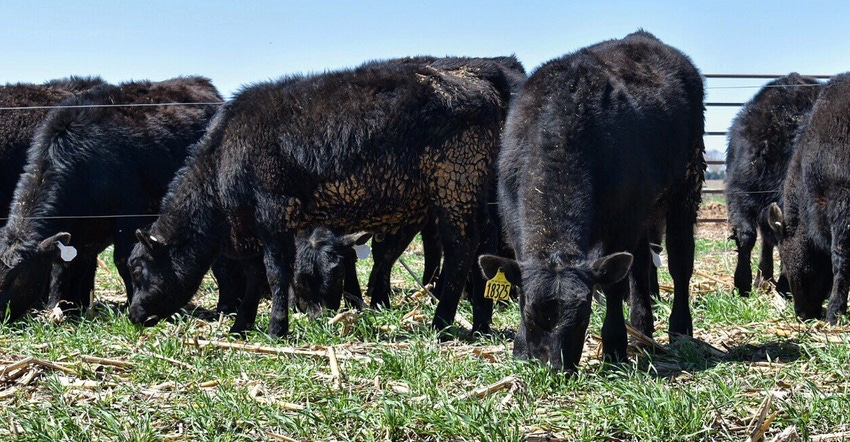November 18, 2019

Cover crops provide many benefits ranging from reducing soil erosion and building soil organic matter to nutrient cycling and scavenging. Another benefit they offer is as an additional forage resource for livestock. Iowa Learning Farms will host a webinar noon Nov. 12 about the studies conducted by Iowa State University on grazing cover crops.
Erika Lundy, ISU Extension beef specialist, and Rebecca Vittetoe, ISU Extension field agronomist, will share what they’ve learned from research on integrating cattle, crops and cover crops. Lundy’s Extension and research programs are focused on beef cattle nutrition and forage management to improve profitability on the farm. Vittetoe focuses on the agronomics, with field and forage crop production and integrated pest management, with a special emphasis on plant pathology.
You still get soil health benefits
Feed expenses continue to be half the cost of production in a typical beef cattle enterprise. “If we are going to have cover crops growing across the state to protect our soil and water, then adding cattle to graze those green forage acres is another opportunity to capitalize on the benefits cover crops can provide,” Lundy says. “One of our primary goals with this research is to answer the question: If we graze cover crops, do we still have the soil health benefits that we know we get from incorporating cover crops into row crop acres? With the results we are generating from this research, we believe the answer is yes!”
To watch the webinar, go to iowalearningfarms.org/page/webinars and click the link to join the webinar shortly before noon to download the Zoom software and log-in option.
Advantages of grazing add up
Farmers plant cover crops and want them to grow and stay green. The idea is not only to help protect soil from erosion and improve water quality, but also to help build soil health, Vittetoe says. If you graze cattle on the cover crop, does that take away from the effectiveness of the cover crop?
“As long as you don’t abuse the cover crop, it will hold soil in place and provide erosion control,” she says. “The cover crop will add to the soil organic matter content in the field, and help the row crop such as corn or soybeans planted in the field following the grazing of the cover crop.”
Cattle also add manure nutrients to help build soil fertility. “They will put back most of the nutrients they consume from the forage when grazing,” says Patrick Wall, another ISU Extension beef cattle specialist. “You want to avoid grazing cattle on cover crops in muddy conditions. Avoid tramping the soil surface and starting to cut paths. If grazing is managed properly, the positive things your soil gets from grazing cover crops will stay there in the field.”
It costs money for cover crop seed and to establish the cover crops in a corn-soybean rotation. Grazing can help pay for those costs. “The easiest way to help cover crops pencil out in a crop rotation is to put cattle out there and get some cheap gains on the cattle and get extra use from the cover crop,” Wall says. “Whether they are feeder calves, stockers, cow-calf pairs or gestating cows, grazing keeps the forage young and growing making it a higher quality forage for cattle to consume. For cows, there’s nothing better for them to graze than a cover crop that’s young and lush.”
Use ‘pluck test’ for grazing time
This fall, with a later-than-normal corn and soybean harvest, it has been a challenge for farmers trying to get cover crops seeded on time and established for fall grazing. When is it best to turn cattle out to graze cover crops in the fall? Should you take soil compaction into account? In a wet fall, should you wait until the ground freezes before grazing?
“For deciding when to put cattle on a cover crop field for grazing, we tell farmers to use the ‘pluck test,’” Wall says. “Take your thumb and forefinger and pinch the cover crop, as if you were a cow picking it up. If you can pull the cover crop plant out by the roots, then it’s too early to graze it, or perhaps, the ground is too wet.”
Whether it’s winter rye, cereal rye, barley, oats or whatever, if you pluck it and the root stays in the ground, and you remove just the leafy part of the plant, “then it’s ready, and the cows can go out there and graze,” he says. “If weather conditions permit, that cover crop will grow faster than the cows can consume it, as long as you don’t overstock the number of cows grazing on the field.”
Source: ISU, which is solely responsible for the information provided and is wholly owned by the source. Informa Business Media and all its subsidiaries are not responsible for any of the content contained in this information asset.
You May Also Like




